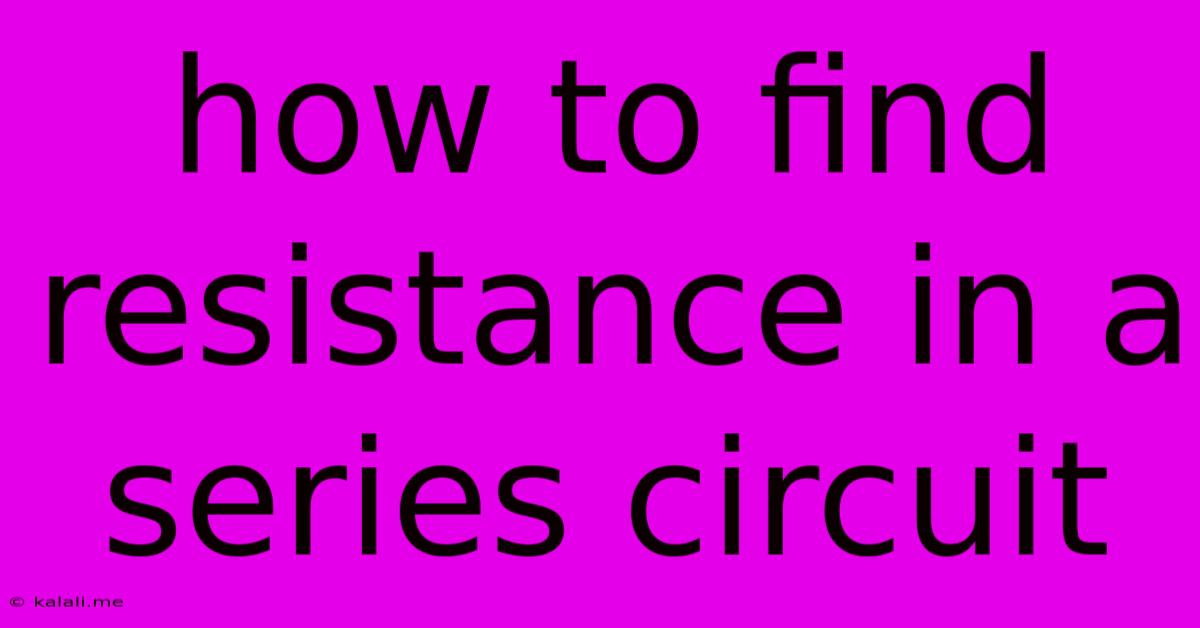How To Find Resistance In A Series Circuit
Kalali
Jun 09, 2025 · 3 min read

Table of Contents
How to Find Resistance in a Series Circuit: A Comprehensive Guide
Finding the total resistance in a series circuit is a fundamental concept in electronics. Understanding this is crucial for anyone working with circuits, from hobbyists to electrical engineers. This guide will walk you through the process, explaining the principles and providing practical examples. This article covers calculating total resistance, troubleshooting common issues, and understanding the implications of series circuits.
What is a Series Circuit?
A series circuit is a closed-loop path where the current flows through each component one after another. Unlike parallel circuits, there is only one path for the current to take. This means the current is the same throughout the entire circuit. This characteristic simplifies resistance calculations, as we'll see below.
Calculating Total Resistance (RT)
The beauty of series circuits lies in the simplicity of calculating the total resistance. The total resistance (RT) is simply the sum of all individual resistances (R1, R2, R3, etc.) in the circuit. This can be expressed mathematically as:
RT = R1 + R2 + R3 + ... + Rn
Where:
- RT is the total resistance of the series circuit.
- R1, R2, R3... Rn represent the individual resistances of each component in the circuit (measured in ohms, Ω).
Example:
Let's say we have a series circuit with three resistors:
- R1 = 10 Ω
- R2 = 20 Ω
- R3 = 30 Ω
To find the total resistance (RT), we simply add the individual resistances:
RT = 10 Ω + 20 Ω + 30 Ω = 60 Ω
Therefore, the total resistance of this series circuit is 60 ohms.
Troubleshooting and Common Issues
While calculating total resistance in a series circuit is straightforward, you might encounter some challenges. Here are a few common issues:
- Incorrectly identifying components: Ensure you correctly identify each component in your circuit before calculating resistance. Misidentification can lead to inaccurate calculations.
- Faulty components: A faulty resistor (e.g., an open circuit or short circuit) can significantly affect the total resistance. Use a multimeter to test individual components to identify any issues.
- Improper connections: Loose or poor connections can introduce additional resistance or create open circuits. Double-check all connections for security and proper soldering.
Practical Applications and Implications
Understanding series circuits and resistance calculations is vital in various applications:
- Designing simple circuits: This forms the basis for designing more complex circuits.
- Troubleshooting electrical systems: Identifying faulty components and calculating total resistance is essential in debugging electrical systems.
- Understanding voltage division: The voltage across each resistor in a series circuit is proportional to its resistance. This is known as voltage division and is a key concept in circuit analysis.
Beyond Basic Calculations:
While this article focuses on the basic calculation of total resistance, it's important to note that in real-world scenarios, factors like temperature and component tolerances can slightly affect the measured resistance. For highly precise calculations, these factors need to be considered.
Conclusion:
Calculating total resistance in a series circuit is a crucial skill for anyone working with electronics. By understanding the basic formula and potential troubleshooting issues, you can accurately determine the total resistance and effectively analyze and design series circuits. Remember to always double-check your measurements and connections to ensure accuracy. This foundational knowledge will serve as a stepping stone to more advanced circuit analysis techniques.
Latest Posts
Latest Posts
-
What Kind Of Oil Does Subway Use
Jun 09, 2025
-
Can X Be Negative In Standard Form
Jun 09, 2025
-
What Do These Words Have In Common
Jun 09, 2025
-
How To Stick Whiteboard On Wall
Jun 09, 2025
-
Removing Wires From Push In Connectors
Jun 09, 2025
Related Post
Thank you for visiting our website which covers about How To Find Resistance In A Series Circuit . We hope the information provided has been useful to you. Feel free to contact us if you have any questions or need further assistance. See you next time and don't miss to bookmark.